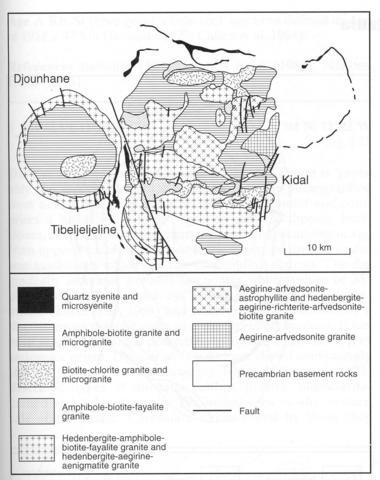stripes
This complex, at 30x24 km, is the largest of those of L'Adrar des Iforas. It is divided by a sinistral fault with a throw of 7 km into the major Kidal part and a much smaller Tibeljeljeline segment to the southwest. The earliest phase is quartz syenite which occupies a polygonal system of dykes, notably to the north and west of the central complex. There followed (Ba et al., 1985) emplacement of amphibole-biotite microgranite then a variably calcalkaline to peralkaline granite which forms most of the Tibeljeljeline part of the complex and much of the southern and western parts of Kidal. This rock varies from a hedenbergite-amphibole-biotite(fayalite granite to a peralkaline variety with aegirine-hedenbergite, sodic amphibole and sometimes aenigmatite. The next series of six granites are all peraluminous and include various combinations of hedenbergite, amphibole, biotite and fayalite. The following intrusion is a major one occupying the centre and northeastern parts of the complex. It comprises two granite types: one contains hedenbergite, aegirine-hedenbergite, ferrorichterite, arfvedsonite and biotite, while the other is an aegirine-arfvedsonite-astrophyllite granite. There followed emplacement of an amphibole-biotite granite and igneous activity was completed by intrusion of aegirine- and arfvedsonite-bearing granites on the eastern margin. The ranges of pyroxene and amphibole compositions are illustrated by Ba et al. (1985) but analyses are not given. Galena, blende, chalcopyrite, pyrite, anatase, ilmenite, marcasite, pyrochlore, zircon and thorianite have been identified in pegmatites. U and Th are comparatively enriched, as discussed by Ba et al. (1985), but with no numerical data.
BA, H., BLACK, R., BENZIANE, B., DIOMBANA, D., HASCOET-FENDER, J., BONIN, B., FABRE, J. and LIÉGEOIS, J.P. 1985. La province des complexes annulaires alcalins sursaturés de l'Adrar des Iforas, Mali. Journal of African Earth Sciences, 3: 123-42.BLACK, R., BA, H., BALL, E., BERTRAND, J.M., BOULLIER, A.M., CABY, R., DAVISON, I., FABRE, J., LEBLANC, M. and WRIGHT, L.I. 1979. Outline of the Pan-African geology of Adrar des Iforas (Republic of Mali). Geologische Rundschau, 68: 543-64.LIÉGEOIS, J.-P. and BLACK, R. 1984. Petrographie et geochronologie Rb-Sr de la transition calco-alcaline-alcaline fini-panafricaine dans l'Adrar des Iforas (Mali): accretion crustale au Precambrien superieur. In. J. Klerkx and J. Michot (eds), Geologie africaine - African Geology. 115-25.

